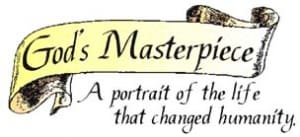.
God’s Masterpiece Technical Considerations

.
God’s Masterpiece is a powerful presentation of the passion of Jesus Christ. It can be presented simply with minimal technical support, or it can be enhanced with many special effects that usher the audience into a multi-sensory experience. Below you will find scene-by-scene suggestions for technical enhancements beyond the obvious need for good lights and sound.
![]() Download the “Technical Considerations”
Download the “Technical Considerations”
General Technical Categories
Lighting
If you do not own a multi-channel, programmable, computerized light board, and an impressive array of stage lights, consider renting them for this production. It makes life a lot easier since the light cues come very quickly, and it is much easier if the light technician just has to push “next” rather than manually cue the lights.
Special Effect Lighting
You will want to create some kind of a scaffold to elevate your lighting. Also, be sure you have the potential to so some tight spot-lighting. This will require blacking out the light in the house.
Sound
On actors
The ideal microphones to use for this production are “face mics.” They are flesh-toned, harnessed to the ear, and extend down onto the face, sloping down the check to the edge of the mouth. A second runner-up to the “face-mics” is the wireless lapel mic. The problem with lapel mics is that the rustling of the clothing causes weird noises.
On areas
Mics that pick up the sound in general areas work well for many parts of this performance. They can be hidden in set pieces. ‘PZMs’ work well as do stationary, omni-directional mics, and hanging mics.
Curtain
God’s Masterpiece can be done without a curtain. You may have to make alterations to the set plan and spread your scenes out a bit more to make the necessary changes, but areas can be created with lighting very effectively. If you have a permanent curtain, all the better, but you might consider installing one to make the scene change between “The Last Supper Table” and “Calvary” and the “Ascension” less obtrusive since they all take place on center stage. Also, it is nice to close the curtain during the “I AM’s of Jesus” in the first act because it is uncomfortable for the disciples to sit perfectly still at the table for 45 minutes!
Background Screen
If you have a white curtain or a screen as a backdrop, you can create some really wonderful lighting effects against it. Drape the front of your church in reflective, white cloth and you will get a multi-dimensional look for the cloud scenes and the special effect lightening.
The Paintings
Study the lighting in the paintings carefully, and do your best to recreate the effect on your background screen. You will need to use floor lights to create some of the depth. Up lighting is very effective and easily movable by stage hands. Be sure all your lights are safe and in proper cans.
Back Stage Lights
Use white Christmas lights to create runways backstage. Those hallways can become deadly! Also be sure stage hands have enough dim stage light to make the needed set changes, and that people can always see their feet, especially men who aren’t used to walking around in long dresses!
Scene-by-scene Technical Considerations
The following is a “scene-by-scene” listing of some technical considerations you may consider to add to the overall effect of the performance. Not all scenes lend themselves to technical wizardry, so you will not find them all represented. These are only suggestions, and the show works very well without them. Do what you can, however, because people love a good show!
The Prologue
“Three Women Remember”
• Dry ice or minimal “stage smoke”
• Wind blowing in their faces, a fan from off stage; it suggests going back in time
.
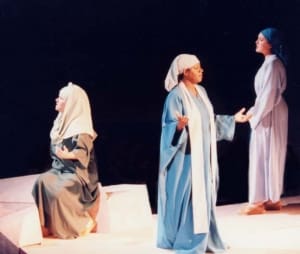

“The Life of Christ in Still-life Poses”
• Create tight spots that isolate each one of the “still-life” tableaus
• Fade out the scenes slowly as the next light pool comes up. This creates a fabulous light show of stage pictures throughout the house.
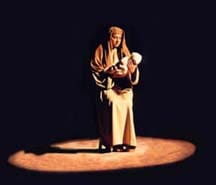

Act 1: “The ‘I AMs’ of Jesus”
Scene 1
“The Upper Room”
Staged Masterpiece from:
“The Last Supper”
by Leonardo Da Vinci
• Create the “Last Supper” backdrop by actually hanging the same backdrop as is seen in the picture. Have one of your artists paint it. If this is not possible, photograph the backdrop and project an image of the backdrop on the back screen.
• The “Last Supper ” table is front lit as well as back lit. When a disciple gets up from the table, it becomes back lit and the remaining men appear in silhouette. When the disciple returns, there is a brief front lit moment and the audience takes in the full effect of the table again. During the “I AMs of Jesus” scenes, the table is in the dark. Preferably, the curtains are closed.
• Be sure Jesus stands in a brilliant spotlight when He pronounces the “I AM” speeches.
.
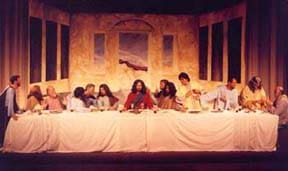

Scene 2
John Remembers,
“I AM the Resurrection and the Life,”
at the “Raising of Lazarus.”
• A bright light coming out of the tomb
• Dry ice or stage smoke coming out of the tomb
.


Scene 5
James Remembers,
“I AM the Good Shepherd,”
as Jesus casts the demon out of the mad man.
• Add “reverb” to the words of Jesus when He casts out the demon.
.


Scene 6
Peter Remembers,
“I AM the Son of God”
at the miraculous catch of fish.
• Create the look of water all around the audience and cast with blue “water light gobos” that alternate and create a ripple effect.
.
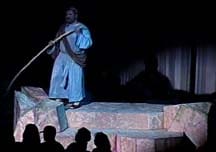

Scene 8
“Judas Remembers another agenda.”
• When Judas makes his deal, put him in a red wash of light at “The Grotto.”
.


Act 2: “The Betrayal And The Persecution”
Scene 3
“The Garden of Gethsemane”
Staged Masterpiece from,
“Christ in the Garden of Gethsemane”
By Heinrich Hofmann
• A bright spot on Jesus as He prays, as though the light were coming down from Heaven.
.


Scene 6
“Peter’s Denial”
Staged Masterpiece from,
“St. Peter’s Denial”
by Rembrandt
• Build a campfire out of real logs on a 2 x 2 plywood base. Place a fan at the base of the logs. Place yellow, red, and white pieces of fabric inside the logs, tacked down and lose on top. Put a light beside the fan. (These “theatrical flame” units can be purchased already assembled.) Attach an extension cord to it that can be powered on/off instantly, from offstage, by one of the stage hands. This is the campfire that Peter stands beside when he denies Christ.
.


Act 3: “The Passion And The Triumph”
Scene 1
“The Crucifixion”
Staged Masterpiece from,
“Crucifixion Le Coupe de Lance”
by Peter Paul Rubens
• Dark, stormy cloud gobos against the back screen. Fans in the audience that blow gusts of air at them, as though they were caught on the hillside.
• Lightning gobos that flash on, just as the lightning claps are heard on the background track (see picture at top of this page).
• Blue and magenta beams that pick up Mary, the Mother of Jesus, and the body of Christ.
.
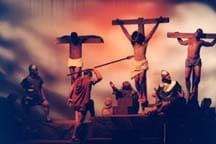

Scene 2
“Mary Mourns”
Staged Masterpiece from,
“The Pieta”
by Michelangelo
• Bright spotlight that shines on Mary, the Mother of Jesus, when she strikes the “Pieta” pose, as though Heaven, itself, had opened on the scene.
.
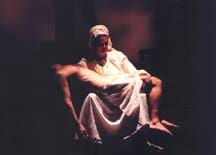

Scene 3
“The Disciples Mourn”
Song:
“A Place For You”
• The same tight spots are used again on this sequence as were used in the opening “Prologue” still-life tableaus of the life of Jesus. The lights fade in and out in rhythm to the music of the song.
.
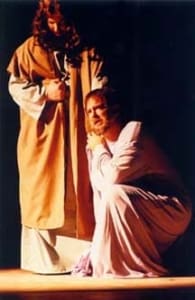

Scene 4
“The Resurrection”
• Install an enormously bright light inside the tomb. Flash the light several times in accordance with the music on the video. The outline of the stone should be seen with the partially open tomb, so that it looks like the power of God is at work.
• Have stage smoke or dry ice pour out of the tomb so that when Jesus appears in silhouette against the tomb in the background, He looks ethereal.
Song:
“I Know That My Redeemer Lives”
• When the women approach the tomb, it should still be smoky and ethereal.
• The Angels stand inside the tomb and are not clearly visible due to the bright light and the stage smoke.
.
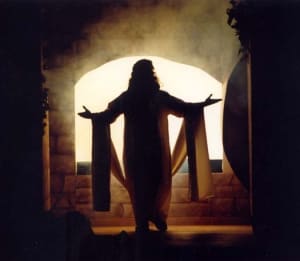

Scene 5
“The Great Commission”
• Cloud lighting against the backdrop
• Fans on stage to create wind as though the disciples are caught up the “rushing wind” of the Holy Spirit.
.
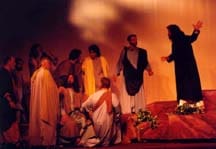

Scene 6
“The Ascension”
Staged Masterpiece from
“The Ascension”
by Rembrandt
• Blackout the stage for a instant during the bridge in the music once “Jesus” has climbed to the top of the set piece that was “Calvary,” but is now the ascension mount.
• After “Jesus” removes his overcoat and stands at the top of the mount in his white resurrection robe, shine a bright beam on him that reflects his glory. (Do your best to recreate the lighting of the painting.)
.
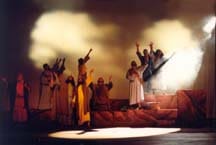

![]()
![]()
![]()
